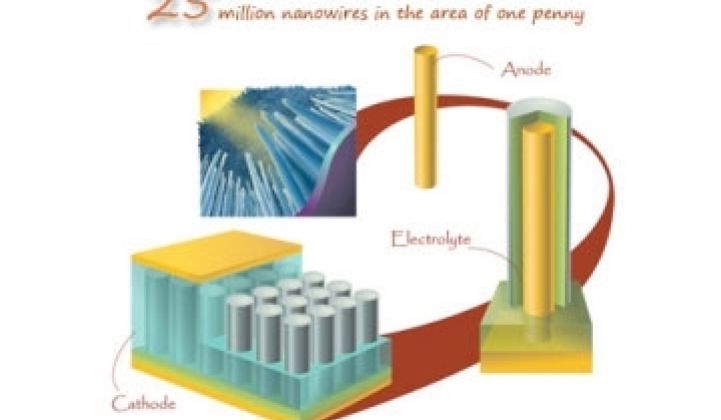Stereos and TVs have shifted from vacuum tubes to chips. Computers are graduating from hard drives to flash memory. Light bulbs are swapping filaments for LEDs.
A group of startups say batteries could soon make the leap to solid state devices.
Orlando, Florida-based Planar Energy claims it has come up with a formula for a crystalline battery that can boost performance, cut costs, make it easier to erect factories and ultimately pave the way for things like inexpensive, mass-manufactured electric cars that can run on the same battery pack for years.
Prieto Battery, a startup out of Colorado State and named after Professor Amy Prieto, is working on lithium ion batteries made with silicon nanowires. (The picture shows Prieto's battery architecture.) Meanwhile, the Khosla Ventures-backed Sakti3 is developing a safe, dense solid-state lithium-ion battery
The secret sauce is in the ingredients. Conventional batteries are like a chemical aquarium constructed of disparate parts: electrons get transferred between an anode and a cathode via a liquid electrolyte. A porous component called a separator prevents short circuits.
In Planar's batteries, the anode, cathode and separator/electrolyte are crystalline, inorganic solids that get sprayed onto a substrate, according to CEO Scott Faris.
"We are essentially printing batteries," he said. "Everything is crystalline -- the anode, cathode separator and electrolyte are crystalline."
Rather than travel via a liquid, the charges migrate through the solids, much in the same way that electrical charges move through flash memory. In fact, a key ingredient for controlling the movement of electrons in flash -- silicon dioxide or ordinary glass -- is found in Planar's separator/electrolyte.
"Flash memory is a really bad battery," he added.
By contrast, Prieto wraps silicon nanowires generated via electrodeposition in an organic polymer that then gets surrounded by a cathode matrix. Nanowires increase the active surface area for transferring electrons between the anode and cathode for rapid power delivery. Satki3 is deliberately cultivating an air of mystery, but check out the video anyway.
Researchers have tried to take solid-state batteries mainstream before, so skepticism exists. Planar received a $4 million DOE grant in April to prove its concept and hopes to have a prototype plant up and running within the next 18 months. The first batteries will sport a lithium manganese chemistry. (For other battery concepts, check out Contour's fluorine batteries, zinc batteries from ReVolt and PowerGenix, and the spray-on porous electrode from Porous Power.)
The shift from liquids and disparate parts to solids creates a number of advantages, according to Faris. First, switching to solids allows Planar to shrink the size of a battery or make a battery of the same size that can hold far more electrons. Approximately 95 percent to 97 percent of the volume of Planar's batteries constitutes active materials (in conventional batteries, only about 40 percent to 60 percent of a conventional battery's volume constitutes active materials). Removing the filler from batteries would directly translate to cars with a longer range or lighter smart phones that can play several movies before needing a recharge.
Second, the crystalline structure opens the door to really large-scale batteries, Faris argues. Most lithium-ion batteries are 2 amp hour to 3 amp hour cells. Planar claims it can do 20 amp hour batteries.
"Traditional battery chemistries were not made to scale to this size," he says. The best analogy here is televisions. TV makers managed to produce tube TVs in the 36-inch range, but after that, the size of the tubes and costs involved made increasing the size impractical. Plasma and LCD were required to get to 42-inch and larger TVs.
Third, it's cheap. The materials get sprayed onto substrates in factories under normal temperatures and pressures. The processes are similar to those applied in the thin film solar industry. Another plus: solid batteries won't experience "runaway thermal reactions" or explosions.
"We can coat an active area for pennies per square meter and reduce the cost of the cell by 70 percent, reduce the capital cost by 60 percent to 70 percent, and increase the energy density by 200 percent to 300 percent."
The disadvantages? It's unproven at the moment. Planar has made prototypes, but has not yet moved toward pilot production. Prieto is developing prototypes.
Planar's crystalline nanomaterials also get arranged through self-assembly, i.e., the inherent chemical and physical forces of the materials that make up the components effectively order themselves in much the same way water molecules form snowflakes.
Chip makers have touted self-assembly for years, but most still rely on vacuum chambers, etching and more brute-force techniques for making microscopic lines and circuits. Self-assembly isn't impossible -- it's just very difficult.
Third, Samsung, Toshiba and others have extensive experience in flash memory and batteries. There's a good chance that all of the Asian manufacturers have solid-state battery projects underway. Battery startups like A123 Systems and Boston-Power have already experienced the challenge of competing against conglomerates.
Faris argues that Planar has a lead in the field and the surrounding intellectual property. And to move into mass production, it will invariably link up with conglomerates. Samsung recently signed an alliance with Nanosys on LED and solar technology: May-September marriages are going to be quite common in green.



